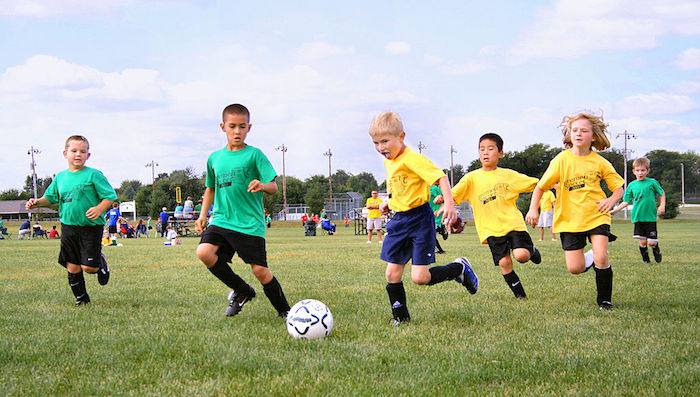
Youth soccer in small town USA.
Photo shot by Derek Jensen (Tysto), 2005-September-17, courtesy Wikipedia Commons.
When you get right down to the divots, polo and soccer have a lot of similarities.
I recently had a weekend that truly exemplified what life is like in Santa Barbara: I spent Saturday on the soccer field and Sunday on the polo field.
At first glance, these two fields seemed to have nothing in common beyond their sneeze-inducing allergens that battle hopelessly with my Claratin prescription (now available over the counter). However, as a trained UCLA sociology major, I am qualified to speculate on sociocultural connections where they exist and to invent them where they don’t.
Both sports involve opportunities for off-roading — you get to park on a beautifully manicured lawn at the polo fields and what could easily be a BMX course at the UCSB soccer fields.
High-density housing tastefully abuts the mountains overlooking the polo fields, while graduate student housing will soon replace the soccer fields, if the university’s plans are ever approved.
Also, there were members of the Firestone family at both venues, which certainly bodes well for the next Board of Supervisors. If Brooks and his offspring can bridge the gap between soccer and polo, surely there’s hope for the battle between north and south Santa Barbara County.
Both sports involve opportunities for mayhem — men charging on horses trying to hit a ball at a goal, and 5-year-old boys and girls running full out trying to kick anything they can, including their teammates.
Both sports apparently also involve cartwheels; although at soccer they take place on the field and at polo they were strictly on the sidelines. Polo is more kid-friendly than you’d think. My son and his buddy ran up and down the grandstand between chukkers, while little girls exhibited spontaneous bursts of gymnastic skill.
Little boys are likely to burst into spontaneous bouts of wrestling and possibly even multiple rounds of jokes, but I have yet to see my son or his teammates do even one cartwheel on the field when the game is going on.
The boys also could care less what color their uniforms are, let alone whether their hair’s brushed, while one adorably pink-clad girls team (the Rainbow Princess Sparkle Dolphins or something) had matching French braids, which were great for keeping their hair out of their faces during cartwheels.
A visit to the soccer field offers opportunities to say hi to everyone you’ve ever met in Santa Barbara, without the conversational expectations of a cocktail party. If Marty Blum and Lois Capps were smart, they’d hold their office hours during AYSO games and get a tan at the same time.
The polo match was more about people watching than people talking. If you’ve ever lusted after a straight-out-of “My Fair Lady” hat at Nordstrom’s and decided you had nowhere to wear it, attending a polo match gives you the perfect excuse. It’s also a great place to bring out that wedding gift picnic basket you thought only people in Town and Country Magazine ever used.
At the soccer field I looked anything but fashionable trying to juggle enormous folding chairs, soccer balls, juice boxes and a small, rowdy boy.
Did I mention that my sociology training qualifies me to speculate on sociocultural connections that may or may not exist?
While snack time is one of the highlights of the soccer game for both boys and girls, the polo matches put on a halftime show that’s a big favorite with bigger boys and girls — the stomping of the divots. Similar to the stomping of the grapes, spectators are invited onto the field to stomp on the grass on their way to a complimentary glass of champagne.
No wonder they call polo the “sport of kings.” Anything that involves sunshine, mountain views and cocktails is OK by me. I hope our soccer team understands that when it’s my turn to bring snacks.
